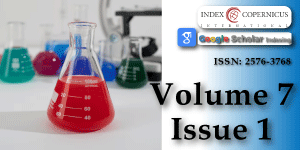Rapid determination of PCDDs, PCDFs and DL-PCBs in foods, feeding stuffs and vegetable oils using new modified acid silica
Main Article Content
Abstract
Polychlorinated dibenzo-p-dioxins, dibenzofurans and dioxin-like polychlorinated biphenyls are persistent organic pollutants (POPs), which in recent years received huge attention due to their extreme stability, high potential toxicity and bioaccumulation in food chains. The main source of human exposure to these compounds is discovered in foods of animal origin, especially foods rich in fat. The target of the present study was to set up an analytical method for the determination of PCDDs/PCDFs and DL-PCB in vegetable oils, sunflower meals, sunflower seeds, rapeseeds and milk powder. The first step consisted of a semi-automatic Soxhlet extraction for 3 hours, by using a mixture of Hexane: Acetone – 80:20, followed by acid digestion with 55% acid silica and filtration. After concentration, the extract is purified on a multilayer column (silica gel, silica-KOH, silica-H2SO4 anhydrous Na2SO4) followed by an alumina column separation in two fractions (first fraction containing PCDDs/PCDFs and second containing only PCBs). The purified extract was then analyzed by GC/MS/MS. The newly developed approach in our lab was capable to reduce the overall time of sample preparation to seven hours/ per sample. Since the method shows good mean recoveries for all labeled congeners spiked in the samples (for PCDDs/PCDFs – 80% - 110%, for DL-PCBs – 70% - 85%), we assumed the absence of overestimation or underestimation in the analyzed samples.
Article Details
Copyright (c) 2023 Ovanes Chakoyan

This work is licensed under a Creative Commons Attribution 4.0 International License.
Van den Berg M, Birnbaum LS, Denison M, De Vito M, Farland W, Feeley M, Fiedler H, Hakansson H, Hanberg A, Haws L, Rose M, Safe S, Schrenk D, Tohyama C, Tritscher A, Tuomisto J, Tysklind M, Walker N, Peterson RE. The 2005 World Health Organization reevaluation of human and Mammalian toxic equivalency factors for dioxins and dioxin-like compounds. Toxicol Sci. 2006 Oct;93(2):223-41. doi: 10.1093/toxsci/kfl055. Epub 2006 Jul 7. PMID: 16829543; PMCID: PMC2290740.
European Commission (EC). Commission Regulation No. 199/2006 of 3 February 2006 amending Regulation (EC) No 466/2001 setting maximum levels for certain contaminants in foodstuffs as regards dioxins and dioxin-like PCBs. Off J. 2006; L 32: 04/02/2006; 34-38.
Ellison SLR, Rosslein M, Williams A. (eds). EURACHEM/CITAC Guide CG4: Quantifying uncertainty in analytical measurement, Second Ed. EURACHEM, QUAM: 2000; 1:120.
Method 1613. Tetra-through Octa-Chlorinated Dioxins and Furans by Isotope Dilution HRGC/HRMS, Revision A. October 1993.
Method 1668 Rev. A: Chlorinated biphenyl congeners in water, soil, sediment and tissue by HRGC/HRMS. USEPA, Washington DC.
Furst P. Contribution of dioxin-like PCB to total toxic equivalents of dairy products. Organohalogen Compounds. 2001; 51: 279-282.
Takakura M, Lehardy T, Marchard P. Analysis of Dioxins in Foods and Feeds Using GC-MS/MS, First Edition. July 2018.
Hamm S, Grumping R, Shwietering J. Levels of polychlorinated dibenzo(p)dioxins, dibenzofurans and dioxin-like PCBs in milk, milk products and eggs from west European countries. Organohalogen Compounds. 2005; 60:199-202.
Vestraete F. EU-strategy to reduce the presence of dioxins, furans and dioxin-like PCBs in feed and food-existing measures. Organohalogen Compounds. 2005; 67:1421-1423.
De Greyt W, De Kock J, Kokken M, KellensM. Removal of Contaminants from edible oils:Current Status and Future Developments.Paper presented at the Lipidforum Seminar on Recent Developments in the Processing of Oils and Fats, Blue Lagoon, Iceland. September 28-20 2000.
Van den Berg M, Birnbaum L, Bosveld AT, Brunström B, Cook P, Feeley M, Giesy JP, Hanberg A, Hasegawa R, Kennedy SW, Kubiak T, Larsen JC, van Leeuwen FX, Liem AK, Nolt C, Peterson RE, Poellinger L, Safe S, Schrenk D, Tillitt D, Tysklind M, Younes M, Waern F, Zacharewski T. Toxic equivalency factors (TEFs) for PCBs, PCDDs, PCDFs for humans and wildlife. Environ Health Perspect. 1998 Dec;106(12):775-92. doi: 10.1289/ehp.98106775. PMID: 9831538; PMCID: PMC1533232.
Fiedler H, Cooper KR, Bergek S, Hjelt M, Rappe C. Polychlorinated dibenzo-p-dioxins and polychlorinated dibenzofurans (PCDD/PCDF) in food samples collected in southern Mississippi, USA. Chemosphere. 1997 Mar-Apr;34(5-7):1411-9. doi: 10.1016/s0045-6535(97)00438-4. PMID: 9134675.
Ramos L, Eljarrat E, Hernández LM, Rivera J, González MJ. Levels of PCBs, PCDDs and PCDFs in commercial butter samples in Spain. Chemosphere. 1999 Jun;38(13):3141-53. doi: 10.1016/s0045-6535(98)00521-9. PMID: 10230050.
Bosio A, Llobet, JM, Domingo JL, Casas C, Teixido A, Muller L. Levels of PCDD/PCDFs in food samples from Catalonia,Spain, Organohalogen Compounds. 2002; 57:105.
EC Directive 2044/44/EC of 13 April 2004 amending Directive 2002/69/EC laying down the sampling methods and the methods of analysis for the official control of dioxins and the determination of dioxin-like PCBs in foodstuffs. OJEC L113/17.

